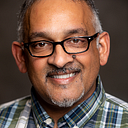25 Years Later: Closer to Home, But Still Not Arriving in Mathematics.
I often forget that I had a teaching career that spanned 19 years. 19. Hmmph. Fitting perhaps for quirky number theory reasons. Adding all the odd numbers from 1 to 19 produces the most familiar of results in shape and number.
If our journey as humans is never to arrive, never to feel oddly settled in both our physical and mental movements, then that journey will most likely leave dreamy and psychedelic trails. Rich and robust experiences and insights that mark our lives with permanence, but not necessarily our directions. We move with purpose. We move with passion. We are unlimited by this.
To UNpredict your journey. This sounds paradoxical. Perhaps absurd. Almost as if we are supposed to be Godot in Samuel Beckett’s play of non-arrival. When we are completely open to all possibilities, we actually surpass any destination or checkpoints we had in mind. We are unrelenting in our pursuits. Every day is seized with equal vigor of curiosity and humility.
Mathematics is a subset of my life, but it doesn’t exist in isolation from other interests and hobbies. It naturally bleeds into other pursuits such as music, travel, food and drink, sports, etc. with the same accessibility and affability.
My personal wanderlust in mathematics seems to be pointing me towards places of interest and hope, finally being able to contribute in concrete ways to two areas of mathematics which have always been close — maybe too damn close — to my heart.
History and Algebra.
A few years back, both of these things were on the margins. Math history seemed to be some optional outpost of exploration, if even that. And algebra, well that topic/subject has been beaten and demoralized with its superficial approach and examination of its utility. The currency has been rather low — ironically — for both these critical threads in the mathematical quilt.
In 2020, the landscape for illumination of these topics has changed markedly for the better. The fluid equity discussions have created a need to reexamine our collective past of mathematics — to ensure that all students have the opportunity to identify themselves culturally in the thematic development of mathematics. Integrated in this history is the practical — yes, practical — evolution of algebra by the creative contribution of Islamic mathematicians in the 12th century.
There are so many rich ideas to unpack, that will take a collective effort for the rest of this decade to give the exposition of math history the justice that it deserves. And, I am grateful to be in a position to help bring more light and relevance to them.
As many of you know, I have worked with the wonderful folks at Buzzmath for the past 4 years. Around the time that I started to work for them, they were the only digital resource company that was devoting serious time to math history.
Just last year, I hosted a webinar on creating more focus in this area. There were over 300 people registered. It felt like that the time for math history to be woven passionately, humanely, and inextricably had finally come.
In 2020, I am going to continue to work in this area of math history, but will be starting two new projects with the companies Amplify and Mathigon — both who are seriously investing in creating interwoven historical narratives in their platforms.
My first project for Mathigon , “Textbook of the Future”, will be to write a complete chapter on one of the most crucial areas of bridging in mathematics.
I am excited to create a rich and vibrant chapter that hopefully offers an imaginative introduction to the elements of Algebra. Will supply more information in a few months!
With Amplify, my role is help curate and heavily color their math curriculum with potent and poignant parts of math history, and bring curiosity and deeper illumination to students and teachers.
What have been some of the best moments so far have been the rich discussions around all the ideas about math history, whether they were well known or not. It has been a communal journey, with all of us sharing tiny patches of historical importance and building larger quilts of narrative/storytelling. Weaving in math history can only be accomplished as a team focused on equity and open to the unknown, prepared to continually re-calibrate the pedagogical vector for learning mathematics.
Being directionless means you are open to all directions — something which the dive into the treasure chest of math history demands not only intellectually, but morally as well.
On Leap Day, I gave a presentation that I will be giving quite a few times into 2020/2021.
The journey to tell this story is woven tightly into my own ups and downs of life. It tattoos humanization to the presentation. The quote by the late Neil Peart has a bit of a mathematical feel, calculus you might say, in terms of only approaching — asymptotic. My presentations will be, in fact, bookended by the wisdom of Neil Peart, and how it pertains to traveling through new landscapes and forging new realities in mathematics.
Closer to its historic purposes…
